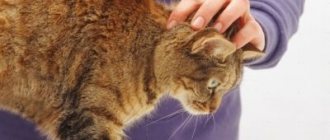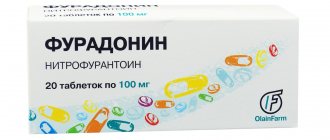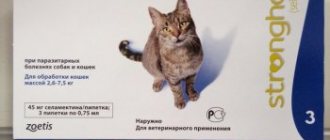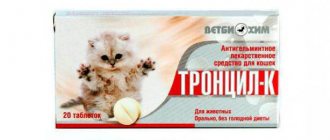Home » Treatment of cats » Canephron for cats
Canephron for cats is a herbal medicine used to treat diseases of the genitourinary system in these beautiful animals. The main feature of this medicine is its composition: medicinal raw materials of exclusively plant origin help not to overload the body with synthetic drugs. At the same time, Canephron not only alleviates the condition of the animal during the acute period of the disease, but also promotes accelerated recovery. And in case of chronic urolithiasis, it reduces the likelihood of relapses.
Compound
Canephron contains:
- centaury grass (Centaurium)
- rosemary leaves (Rosmarinus)
- roots of lovage (Levisticum officinale)
Centaury
Biennial, less often annual, plant of the gentian family. Representatives of this family contain bitterness, glycosides (eritaurine, erythrocentaurine), flavonoids, oleanolic acids, gentianine alkaloid, chromium salts.
Centaury grass is credited with many beneficial properties. In the register of medicines of the Russian Federation, centaury herb is listed in the group of appetite stimulants of plant origin (bitterness), has a stimulating effect on intestinal motility and the secretion of glands of the gastrointestinal tract (GIT).
Rosemary officinalis
Evergreen shrub of the Lamiaceae family. The leaves of the plant contain alkaloids, ursolic and rosmarinic acids, and essential oil. Rosemary essential oil contains: pinene, camphene, cineole, borneol, L-camphor, sesquiterpene hydrocarbon caryophyllene, bornyl acetate, limonene, resins and bitterness.
It has the following medicinal properties: tonic, bactericidal, balsamic, antiseptic, diaphoretic, antirheumatic, hypotensive, analgesic, choleretic, antispasmodic, diuretic.
Lovage officinalis
Perennial herbaceous plant, fam. umbrella All parts of the plant contain essential oil, which contains: D-terpineol cineoacetic, isovaleric, benzoic acids. The following were found in lovage roots: resins, organic acids (angelic, malic), starch, sugars, carvacrol, sesquiterpenes, furocoumarins (psoralen and bergapten), tannins and minerals.
Lovage is not used in scientific medicine, and just like rosemary leaves, it is not included in the Register of Medicines of the Russian Federation. But it is registered in some foreign pharmacopoeias. It is believed to have a diuretic, expectorant, tonic, analgesic, sedative effect, relieve spasms, and promote the removal of stones and sand from the bladder and kidneys.
Contraindications for use
The medicine can harm cats with diseases:
- Ulcerative formations in the stomach;
- Ulcerative formations in the intestines;
- Hypersensitivity to the components of the drug;
- Liver and kidney failure.
Side effects occur in case of overdose or allergy:
- Allergic reaction in individual cases;
- Vomiting and nausea;
- Diarrhea and intestinal disorders;
- Nervous disorders.
When the first symptoms of a drug overdose or an allergic reaction appear, you should stop taking the medication and immediately consult a veterinarian.
Release form
The drug is produced in 2 forms: pills and drops. Both are used for cats, each has its pros and cons.
The pills contain more excipients, which increases the likelihood of allergies or adverse reactions. The tablets are covered with a protective coating, which, if violated, reduces the effectiveness of the drug.
The drops contain ethyl alcohol, which has a negative effect on the pancreas and liver of cats. But it’s easier to give and dose drops.
For children
For children over one year of age, Canephron is prescribed in the form of drops. The tablets are indicated for use from the age of six.
However, the drug is often prescribed to children under one year of age. The optimal dosage for infants is 30 drops per day, divided into 3 doses.
The medicinal plants that are part of the solution are well tolerated by children, and the concentration of alcohol in it is not so high as to harm the child’s body. Therefore, it is believed that Canephron is absolutely safe for infants under one year of age.
In this case, the drug can be used for a long time and in combination with any other medications.
The only side effects may be allergic reactions caused by individual intolerance to one or another component.
pharmachologic effect
Diuretic (diuretic) product of plant origin. Used for the treatment and prevention of diseases of the excretory system in cats: nephritis, urolithiasis, uremic syndrome, cystitis - as part of complex treatment. The use of Canephron for chronic renal failure (CRF) is controversial.
The essential oils and flavonoids that make up Canephron dilate the blood vessels of the kidneys, thereby improving the nutrition of the renal epithelium, increase diuresis, but do not increase the excretion of potassium from the body (potassium ions are important for the normal functioning of organs, primarily the heart).
Rosmarinic acid has an anti-inflammatory effect. Flavonoids and rosemary oil relieve spasms, reducing pain in the cat.
The drug reduces the amount of protein excreted through the kidneys, which helps maintain normal blood composition in a sick animal, prevents the formation of uroliths (stones) in the kidneys and bladder, by restoring normal urine pH. Normally, cat urine does not contain protein, but during inflammatory processes, the normal process of blood filtration and urine formation is disrupted. Blood protein leaks through the kidneys, damaging their epithelium and acidifying the urine.
Canephron has a bacteriostatic effect - it interferes with the normal functioning of bacteria that cause the disease, including those that are insensitive to antibiotics. The drug combines well with antimicrobial drugs, enhancing their therapeutic effect and reducing side effects due to its diuretic effect.
When to use
The drug "Canephron" can be used for cats with a number of diseases of the urinary system. Often this herbal medicine is taken as an auxiliary treatment. This is an excellent additional remedy for antibiotic therapy.
For pyelonephritis
Pyelonephritis (inflammation of the kidneys) can occur in these animals due to infections and parasites entering the urinary system, due to the presence of stones or other causes of stagnation of urine, and can also be a reaction to certain drugs and chemical compounds.
It is often a consequence of untreated cystitis.
This disease can cost your pet his life, so it is very important to notice the symptoms in time and contact a veterinarian
With this disease, the cat becomes lethargic, drinks a lot and experiences pain when urinating, its appetite decreases, vomiting, fever, and palpitations may occur. There is a change in the smell and color of urine.
Treatment for this disease is aimed at eliminating the causes, and after examinations, antibiotics are often prescribed, and the cat is switched to food with a low protein content. Diuretics and herbal medicines, including Canephron, are included in the treatment complex and contribute to a faster recovery.
Did you know? Cats have lived together with humans for a very long time. This confirms the burial of a man with a kitten on the island. Cyprus, which is about 9500 years old. Cats were brought to the island by people intentionally.
For glomerulonephritis
This is an immune disease that causes inflammation in the kidneys. Glomerulonephritis usually develops after infections or against the background of other pathologies.
Sometimes the disease can appear after trauma to the peritoneum, tick bites, long-term consumption of unbalanced food, or due to an overdose of certain drugs.
In the initial stage, the disease is often asymptomatic, but it is usually indicated by darkening of the urine, the presence of inclusions, and an unpleasant odor. There may be other signs of the disease - swelling, lethargy, poor appetite and vomiting, deterioration in appearance, frequent urination, accompanied by pain.
At an early stage of the disease, the animal can be cured. After identifying the causes, complex therapy is carried out. Canephron may be prescribed for her to reduce inflammation and pain.
The drug will help restore kidney function. During treatment, the cat’s diet and living conditions are also reviewed.
For cystitis
Cystitis (inflammation of the bladder) in cats is provoked by infections, drafts, stress, poor nutrition, as well as the presence of another disease of the genitourinary system.
Neutered cats are most prone to it. Often, the acute form of the disease with improper treatment (or lack thereof) develops into a chronic form.
The presence of cystitis can be suspected if the following symptoms occur:
- frequent urination;
- impurities in urine and its unpleasant odor;
- lethargy;
- febrile conditions.
Treatment after testing is prescribed by a veterinarian. Depending on the results of the examination, he decides whether Canephron will be the main or additional medicine. The herbal medicine will be useful for the chronic form and as a preventative measure for frequent cystitis.
For cystitis in cats, the drug “Stop Cystitis” is also used.
For urolithiasis
The most common causes of stones are poor diet, hormonal imbalance, excess weight and low mobility of the animal. Often, if they are present, it is necessary to undergo surgery. "Canephron" is used to prevent the appearance of sand and kidney stones.
It is reasonable to take it after surgical intervention in courses several times a year. The dosage of the drug for urolithiasis is prescribed by a veterinarian. At the same time, cats must have their diet adjusted and their drinking regime monitored.
For chronic renal failure
Chronic renal failure, when the kidneys cannot cope with their work and the body is poisoned, is a serious disease.
This disease can develop against the background of kidney stones, weak immunity, congenital and acquired kidney pathologies.
Did you know? The oldest cat listed in the Guinness Book of Records is Crème Puff from Texas (USA). He died at the age of 38, although cats usually live no more than 20 years. Since 2011, he was replaced from the first position by the cat Lucy from Great Britain, who lived for 39 years.
Instructions for use and dosage
Before use, consultation with a veterinarian is required. Canephron is a medicine tested and used in humanitarian medicine; the instructions for use do not contain a dosage for a cat. It has been used recently in veterinary medicine, so there are no standard prescriptions for cats; the amount of the drug depends not only on the weight of the animal, but also on its physiological characteristics and severity and condition. Prescribe 5-10 drops per adult cat 1-2 times a day. It can be given either by mixing with water or adding to food. If tablets are prescribed: 1/2 - 1/4 tablets 2 times a day. But when dividing the tablet into parts, the shell is broken, which significantly reduces the effectiveness of the drug. The duration of the course is from several days to 1 month.
Canephron N (drops) contains alcohol. The strong smell repels cats. When mixing with water, you can wait a little (10-30 minutes) for the smell to weaken or disappear.
What to do if a kitten has hemorrhoids
Hemorrhoids are considered to be a pathology that only affects humans, but in cats, like other animals, it is understood as any disease associated with inflammation of the anus. However, in a number of foreign veterinary reference books there is a description of hemorrhoids in cats, but this is rather an exception.
We will talk about whether cats get hemorrhoids, what diseases are confused with it, and how to treat your pet correctly.
Causes of hemorrhoids in cats
What causes hemorrhoids in a cat?
Walking on two legs, upright posture, is one of the characteristics of man, which not only distinguishes him from animals, but also has a number of negative aspects.
A person’s center of gravity is shifted, which leads to diseases of the spine and poor circulation in the pelvic area, which leads to hemorrhoids in cats.
In cats, the center of gravity is fine, but problems with the intestines and blood vessels arise for a number of other reasons.
https://www.youtube.com/watch?v=ZYzB851_h1A
The most common ones are the following:
- improper and inadequate nutrition. Leads to a number of diseases, including hemorrhoids. Most often, those cats that get sick are those that are fed only cheap dry food from the store;
- digestive disorders. A direct consequence of poor nutrition, which leads to constant constipation and disorders;
- overweight. A frequent companion of apartment cats, it can also appear after the cat has been castrated;
- lack of physical activity;
- diabetes and a number of other diseases that lead to the walls of blood vessels and veins losing their elasticity and firmness;
- hormonal disorders;
- helminths, in simple terms, worms.
All these factors lead to the fact that the veins lose their tone, and blood stagnation begins in them, nodules form. Moreover, these nodules can be either inside or fall out through the anus.
Inflammation of the anal glands
What diseases are hemorrhoids confused with in cats?
In cats, in the rectum near the sphincter there are two anal glands, which produce a secretion that is not only the source of the individual smell of the animal, but also a powerful antiseptic.
In addition, they secrete a “lubricant” that facilitates the passage of feces. It is the inflammation of these glands that is most often mistaken for hemorrhoids.
Meanwhile, an attempt at improper treatment will lead to the formation of fistulas and a severe inflammatory process.
Itching in the anus
The cat begins to “ride” along the floor with its hind end, the hair falls out around the sphincter, inflammation and swelling appear. A very common occurrence with worms.
Rectal prolapse
Rectal prolapse occurs in cats as a consequence of long-term digestive disorders, as well as with senile changes, when tissues and muscles lose their firmness and elasticity. Bowel prolapse is very similar to, but is not, the later stages of hemorrhoids.
How to treat hemorrhoids in a cat
How to cure hemorrhoids in a cat
If the pathology is detected at an early stage, then the treatment will be quite “gentle”; the main thing in it will be to normalize the animal’s nutrition so that its gastrointestinal tract works “like a clock.” You will have to forget about dry food from the store. The diet should be as balanced as possible, with all vitamins, minerals and trace elements.
Pay special attention to fiber, it is responsible for the normal formation of feces and bowel movements. Wash your cat's anus several times a day with warm water, without using soap or other means.
After the procedure, lubricate the anus with a small amount of Levomekol, Vaseline or sea buckthorn oil.
If hemorrhoids are already severe, then suppositories will be necessary in the anus, which will relieve inflammation and pain.
If a cat’s hemorrhoids have reached an advanced stage, then it is too late to carry out drug treatment—surgery is necessary. It is performed in a veterinary clinic. There are two main methods: excision of hemorrhoidal cones under general anesthesia or freezing them with liquid nitrogen under local.
Use of Canephron in cats: controversial issues
At the moment, there are no scientific studies, confirmed data on testing Canephron and verifying its effectiveness for cats. Reviews about the drug on the Internet from animal owners and veterinarians do not lead to a consensus. Phenolcabolic acids, which are part of Canephron, can have a toxic effect on the liver of cats, like other phenol derivatives. The harm/benefit ratio for cats when using alcohol and terpene compounds in the medicine is unclear.
Canephron during pregnancy
Is it possible to take Canephron during pregnancy? The answer to this question is yes.
Since the drug contains a complex of medicinal plants, expectant mothers are often prescribed Canephron for cystitis, pyelonephritis and glomerulonephritis, as well as for a number of other problems with the urinary system.
Many women are also interested in whether Canephron is a diuretic or not, and whether pregnant women can take it for edema.
As the manufacturer indicates, the drug has a pronounced antimicrobial and antibacterial effect, relieves spasms, prevents the development of infections in the urinary tract, improves the functional state of the kidneys and bladder, which experience increased stress during pregnancy and often need support.
In addition, drops and tablets have a diuretic effect, which allows them to be used as a remedy for swelling that can accompany pregnancy. The drug helps reduce swelling, reduces the intensity of lower back pain and improves the overall health of women.
In some cases, the doctor may recommend taking Canephron N to prevent gestosis and exacerbation of various types of renal pathologies, which are extremely undesirable during the period of bearing a child.
So, why is Canephron prescribed during pregnancy:
- for the treatment of infectious and non-infectious diseases of the urinary tract (the drug is effective for cystitis, interstitial nephritis, pyelonephritis, glomerulonephritis);
- for the prevention of nephrolithiasis (kidney stones);
- to reduce protein excretion in urine.
One of the advantages of the medicine is that it can be safely taken for a long time, if necessary (including during breastfeeding).
In addition, the use of Canephron during lactation does not oblige a nursing mother to switch her baby to formula and cereals, but allows her to continue breastfeeding without fear of harming the baby’s health.
The standard dosage of Canephron during pregnancy is as follows - 6 tablets or 150 drops with a frequency of applications 3 times a day. However, sometimes during pregnancy the tablets are prescribed to be taken 1 twice a day, and the solution - 25-50 drops twice a day.
Despite the fact that the drug has virtually no contraindications and rarely causes unwanted side effects, it should be remembered that its main components - rosemary and lovage - have the ability to increase the tone of the uterine muscles.
In their pure form, these plants are contraindicated for pregnant women, therefore, when treating with Canephron, you should strictly adhere to the regimen prescribed by your doctor.
Analogs
Drugs similar to Canephron in composition and action:
- Cyston (a drug of plant origin. Available only in tablets. It contains more different herbs, but because of this, the risk of allergies is greater);
- Phytolysin (paste based on essential oils and medicinal raw materials of plant origin. Effective for urolithiasis, but has a very strong odor);
- Phytoelite healthy kidneys for cats (tablets based on extracts, decoctions and infusions of medicinal plant materials)
- Kotervin (water infusion of medicinal herbs for cats, has a diuretic, salt-removing and anti-inflammatory effect)
- Stop-cystitis (suspension containing both extracts from medicinal plants and synthetic drugs with antispasmodic and antibacterial effects)
- Nephroprotector Divopride (tablets based on bearberry and Pol-Pala extracts for the treatment of diseases of the urinary system with mild edematous syndrome, diuretic).
The possibility of replacing the drug with an analogue is determined by the veterinarian.
History of the drug
The first mention of Canephron appeared in 1934 in Germany, and it was from that moment that the drug began to be popular among people due to its medicinal properties. In veterinary medicine, this medicine began to be used relatively recently and with its help you can quickly get your pet back on its feet.
Herbal medicine Canephron
Important! The drug consists exclusively of natural ingredients that are not harmful to health.
Composition of the drug
Canephron is available in the form of drops (50 and 100 ml bottles) and tablets. The drug contains only plant components such as lovage, centaury and rosemary. Also includes distilled water and aqueous-alcoholic extract of these plants.
Each component has its own role in the action of the drug:
Rosemary promotes normal blood circulation in the kidneys, improves the digestive process and helps destroy bacteria. Lovage has a diuretic effect, and this is very important for removing infections from the urinary tract. Centaury reduces inflammation and prevents the formation of kidney stones.
Active substances, together, effectively cope with many diseases.










